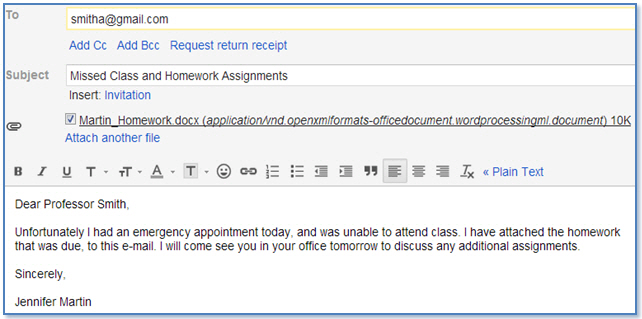In a college setting, whether you’re in an online class or a face-to-face classroom, email is one of the most common ways you’ll interact with your professors. Many students make the mistake of thinking emails are very informal, but when you write your professor an email, you should use a professional tone, one that you would in a professional setting. In both academic and professional settings, emails are one of the most common forms of communication. With that in mind, it’s important to develop some good strategies for writing emails.
Emails are as important to making a good impression as a face-to-face conversation. Therefore, making careless mistakes or using a tone that is too informal can be detrimental to academic and career success. Often professors and potential employers remark that students and college graduates still write emails poorly; they frequently do not show the proper subject line, attachment, respectful title, greeting, tone, grammar, punctuation, or salutation. A poorly written email may look like this:

There are several errors in the above example. The subject line does not appropriately describe what the message will contain, nor is it capitalized. There is no attachment in the message, despite the author claiming there is. The message is also missing a greeting, and there is poor grammar and spelling. The smile at the end is unnecessary as well. The author has not reflected on who would be reading the document, that person’s position, or in what context he or she would be reading the message. A more appropriate email would look similar to this:

Two important things to consider before writing an email are the audience and tone of the message. The above message is directed toward an academic professional; therefore, the author uses the correct title, greeting, and salutation. The tone is also professional, and there are no spelling or grammatical errors. The author also writes in full sentences, is respectful, correctly attaches the document, and has a more specific subject line.
Although the tone of a message directed toward a professor or employer is quite professional, it’s important to note that all messages need not be uniform. Some stylistic freedom is allowed in the greeting, body, and salutation of the email. For example, it’s acceptable to write good morning or good afternoon, instead of dear. It is also acceptable to write thank you instead of sincerely. However, it’s inappropriate to add emoticons, incorrect abbreviations, or faces made with punctuation marks in professional emails, especially to people you don’t know well.
